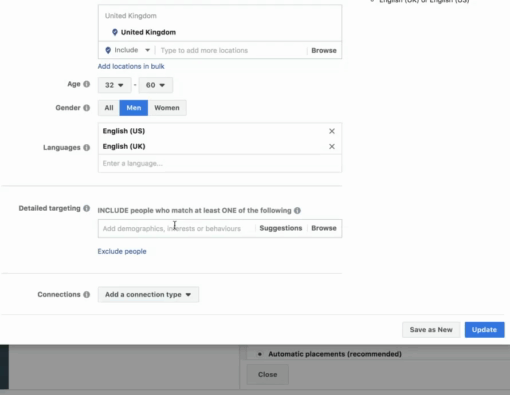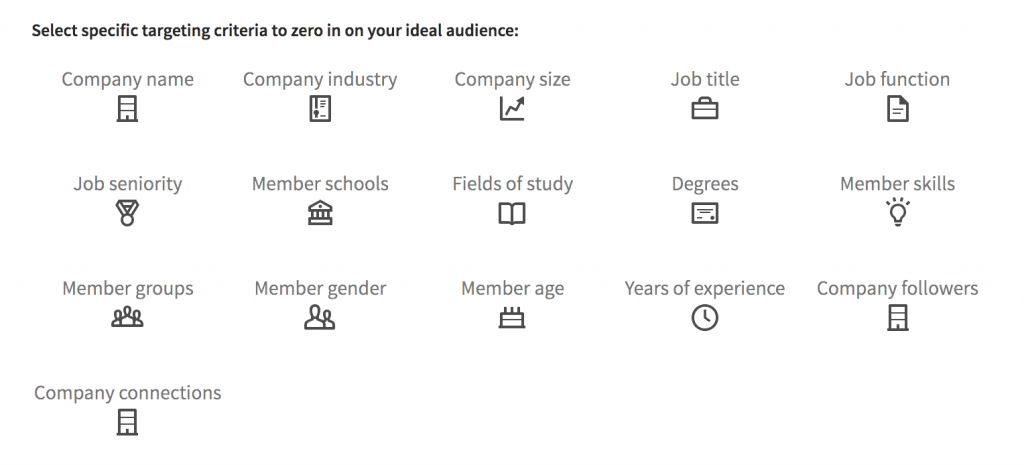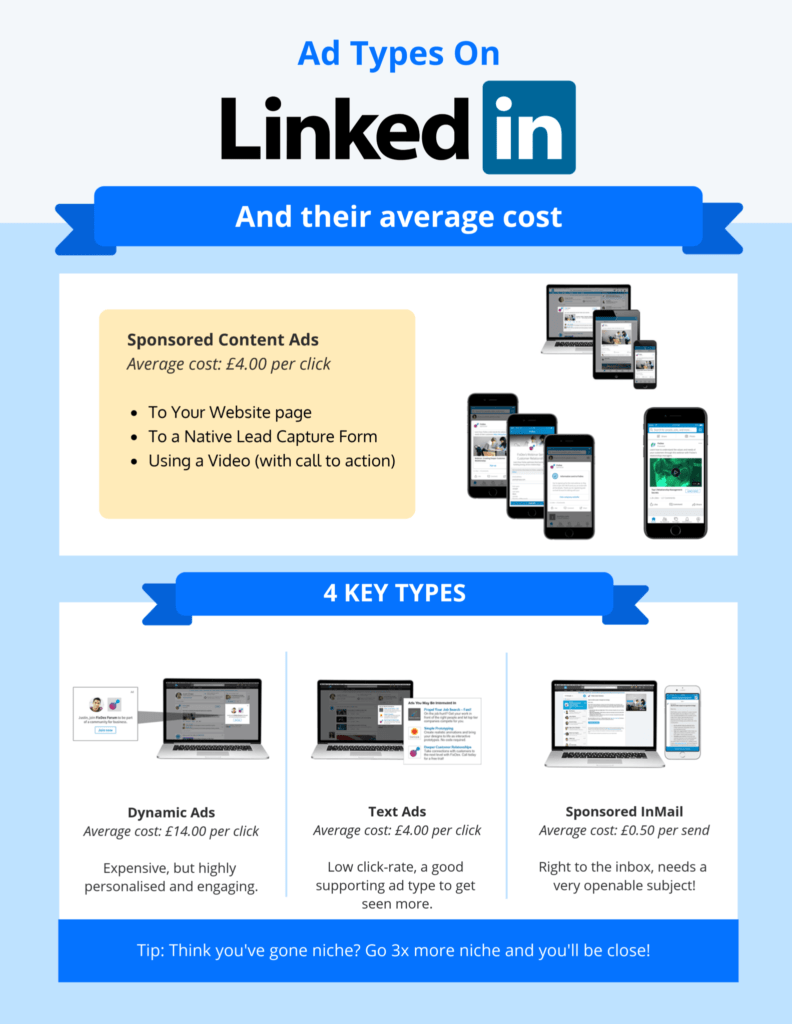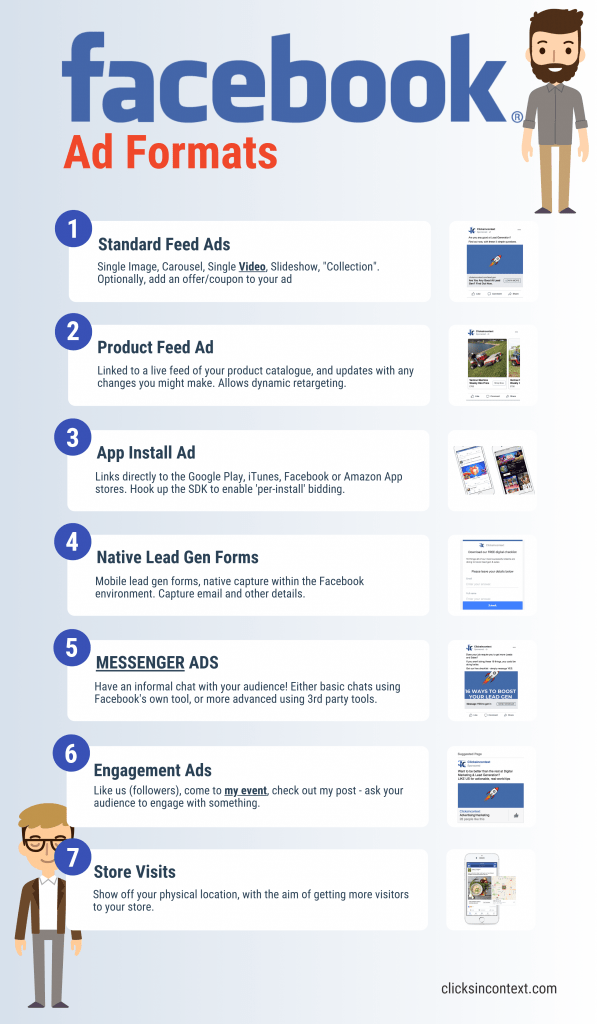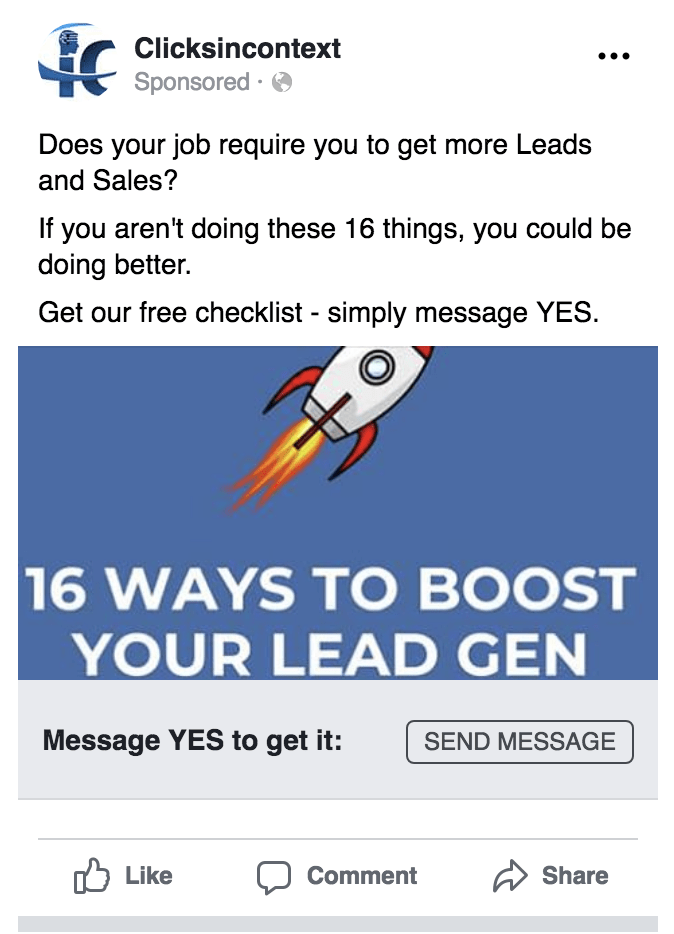Getting LinkedIn Ads To Work
*BONUS* – Handy tips on Facebook Ads, Google Display Ads also included.
LinkedIn ads are HARD.
But if you get it right, wow the data is gold.
We will gently touch on Facebook ads in this article too, which is often mistakenly labelled as “not for businesses”.
The Right Message, To The Right People
A very targeted audience (which we’ll go into) seeing your very targeted message just for them, speaking their language, that is what it’s all about.
Where the likes of Coca-Cola have an extremely broad target audience, most of us do not. If you really think about it, you can nail down; job titles, business types, interests, income, parental status etc… and create a very precise buyer persona.
Start by thinking inwards, looking at existing clients, and just crack 1 persona to start with – more can and will develop in future.
Step #1 – What Is The Goal?
Of course, the goal is usually to make £millions and become a hero. But think detail.
Scenario A – Webinar > £1k Product Purchase
You probably have a financial goal, or a numbers goal like sign up 10 people to my product (let’s go with an online course).
Okay, so to get 10 people to signup FROM your Webinar, with a 5% conversion rate (average), you need 200 people to attend that Webinar.
BUT WAIT! Only about 25% of signups actually show up to a webinar (more if you’re clever with reminders and copywriting).
You actually need 800 signups to get you your 10 buyers.
Scenario B – Lead Capture for Big Ticket (£20k+) B2B Purchases
This is less ‘smash-and-grab’ in a week and more about nurture – because the sales cycle is longer.
You need to be there when they are ready-to-buy.
At this level, yes you do get “ready-to-buy” leads directly, mostly through high-intent Search terms but also via display chains.
In the B2B world, you also have a wealth of company data on visitors to your site (if you don’t, stop right now and go get it! And email us if you want a free trial of some Business Lookup software) – your sales team should be getting some valuable conversations filling up your sales pipeline (if you aren’t, or don’t have a sales team, also email us – we know very experienced ‘lookup calling’ partners).
They will be a massive minority though, you absolutely must nurture, nurture, nurture.
Most of the signups will not be ready-to-buy. You need to be there when they are and also calculate your goals differently.
e.g. if you capture 20 prospects per month (and yes, @gmail.com and @outlook.com are prospects if you are willing to nurture properly), over a year that’s 240 prospects who showed interest in your product/service. NOW YOU NEED TO IMPRESS THEM. It is likely you will have a long sales cycle, so you have a long time to get into their heads – help them, impress them, and when they need you, you will be their go-to company for that product/service.
Get just 2% of them to buy your £100k B2B service in the long-run and you just made £500k from collecting 240 email addresses………
And you can do much, much better than 2% if you put some good resource to it!
And it’s not *quite* that simple…
- What is the lifetime value (LTV) of those buyers? Most buyers of something buy more in future…
- What is the lifetime value (LTV) of the new email contacts you acquire over time – beyond initial converters?
- When you do a good job for them, what is the referral value?
In competitive industries, the competition will already have all of this tied down into their calculations. You need to too.
WANT TO CALCULATE YOURS RIGHT NOW? It takes 5 minutes, go ahead here:
Pitfalls we see regularly at this stage:
- not even doing this step!
- pie-in-the-sky targets
- unrealistic cost-per-signups for the audience/channels
- no accounting for lifetime value – only accounting for immediate revenue. Growth companies always account to LTV
Step #2 – Who Is The Audience/Persona
Display success = the right MESSAGE to the right AUDIENCE.
One obvious audience is re-targeting website visitors and social followers – people who already know your brand. We cover this later in “the message” and “nurture“.
You need to get into the audience details before you can create the right, highly specific message.
Here are some things to think about, noting that in some Ad Networks you can get down into even more detail.
You’ll be amazed what you can target, people really have no privacy online, it’s true.
It’s also a myth that Facebook is not a great source of B2B leads, it is in fact probably the best – depending on the ad format you choose (more on that later).
Here’s an example:
Imagine an IT Services company getting “Don’t start your next IT project *HANS SOLO*” in front of this audience above! And the cease and desist that would follow from Disney shortly afterwards… just an example, you get the idea.
And then there’s LinkedIn Ads, so much choice it can overwhelm you:
And we wrote a whole article on Google’s Display Network targeting options, which can get right down to specific YouTube videos.
All of them enable email list matching too – if enough match, you can serve a campaign to your email list.
Pitfalls we see regularly at this stage:
- not going niche enough – go more niche
- “Facebook isn’t for businesses” – incorrect
- crap external data (e.g. company lists, customer match lists)
Step #3 – The (Initial) Message
Okay, so we have our 32-60yr old IT Seniors who love Star Wars… what do we say to them, and via which medium?
There are a lot of medium options. Facebook has tonnes of combo types, LinkedIn Ads has 5 or 6, and Google Display tonnes if you look into the options available via Google Web Designer.
Facebook Ad Types:
Google options are endless, you can do anything you like in HTML5 – or just use their inbuilt “Responsive Ads”, as well as pure video ads:
There really is a best medium for each stage of the funnel – from cold to warm to red hot.
You will more than likely spend thousands just working this out. If you would prefer to just know now, go ahead and ask… you will receive.
The answer to what the message should be can be broken down to:
What would resonate with this kind of person, and what do I have of benefit to them that I can give away for free and is related to my product/service
There is no right or wrong answer, we recommend trying a few different angles and building on them. What you think will do best, won’t.
Here is an example we have run, which captured Sales Director (usually very competitive people) leads at £4 per signup:
There are variations playing on more specific interests – e.g. Rugby (a common love amongst Sales Directors, we have discovered over time) – simply change the imagery, or drop a Rugby pun, seriously this kind of thing works!
A Note On Retargeting Messages
A bog-standard campaign for all channels is retargeting people who already know you – visited or engaged in certain ways, however you like to define it.
In B2B, run a video case study to these people. You’re welcome.
If you’re a catalogue site, run 1x dynamic product feed and 1 full product feed carousel to these people.
And there is a very cool method we call “The Flytrap” – it involves throwing out some (very relevant) teaser content before getting your initial message out there, and it can halve your cost-per-signup if executed properly. It’s especially effective on Facebook.
A Note On Google Display Network Messages
Google’s standard is their very own “responsive ads”, which are ok most of the time – but can be ugly, or at least just the same as everybody else’s.
Also, if you are a high-ticket B2B provider, you might want to get a bit more classy, which is easily done with HTML5 banners.
If you can afford it (£100 per set) we would always recommend having an HTML5 set as well as responsive.
To test all the messaging properly takes a lot of effort, and a decent enough budget to get each test enough clicks for statistical significance.
Pitfalls we see regularly at this stage:
- Crap messages are forgivable – just testing 1 message is not (exception: if by chance it is working great!)
- No measurement/tracking/pixels in place (blind spend)
Interlude – Biggest Dangers With Display
You need robots to manage and optimise Display – as it develops, it becomes complex.
You can have hundreds of ad variations targeting 40 slightly different audiences in a complicated web unmanageable for people, at least within reasonable working hours.
If you’re going to take Display seriously, you need robotic help. We already have an army of them, developed over a decade – without them, we would need 50 more staff.
If you don’t know what click fraud is, and how to identify it immediately with robots checking it every day, stop right now. You cannot run Display yourself until you understand this fully. Sadly, the Display advertising world is riddled with click-fraud and some big names don’t do enough to deal with it in our opinion. A sad truth.
If you want to capture email and don’t know what a honeypot is, email us before you get started – you need to know.
YOUTUBE IS INCREDIBLY DANGEROUS – tens of thousands can be wasted there with seemingly sensible targeting options. We estimate billions is wasted worldwide due to just one little quirk in the YouTube targeting.
Desktop and mobile are very, very different beasts when it comes to Display (and to a degree, Search too). The different device settings in the various networks can destroy your campaign before you’ve even started. Again, billions are wasted worldwide in not understanding the tacit nuances.
There at least 10-20 other money-drains, the tacit knowledge you’ll only work out with years of experience (after wasting a lot of money!) – so seriously, take us up on our offer to just email us about any of these things, that email could save you a fortune and we will respond.
Step #4 – Nurture
The initial hook is just the start. You’ll get signups flowing in, some of them will be very exciting indeed.
Whether Webinar or Lead Capture, you now absolutely must have a carefully planned nurture sequence in place. i.e. on-going messages.
The goal: warm up, by giving away more free benefits mixed with the occasional bolder ask. Be there when they are ready-to-buy.
About this nurture sequence: if it is crap, people will not be impressed and you will not gain anything from your leads.
It’s important, spend time planning it.
Nurture is not restricted to email, it is a combination of some or all of:
- Email sequence 100% relevant to the topic they opted into
- Re-targeting Display Ads
- Direct Mail (yes, if it’s clever it still works) – at certain trigger points
- Sales Calling – at certain trigger points. Persistence matters.
- End-of-email-sequence >>> move to your standard list (e.g. newsletter)
Download yourself a copy of this Google Drawing and use it as a template for your own nurture ideas.
Q: How long does this go on for?
A: How long is your sales cycle?
You don’t need to do all of these at once to succeed, but the more you do the more you’ll succeed.
Pitfalls we see regularly at this stage:
- not bothering to do any of it
- not automatically posting leads to CRM
- B2B – not doing the sales calling part. Done right, 70% of all results can come from this alone
- overwhelm – a simple automated email sequence takes 4hrs to set up (under £100!)
- sales cycle length – doing 1 month then dropping it, for a 12 month decision cycle service
Summary
It is sooooooo easy to waste a lot of money when handling display advertising. One tick box too many or few, a seemingly innocuous targeting setting, and basic structural things can cost thousands in ad spend and years in wasted time getting it wrong.
If we can help anyone avoid that, we will – client or not just drop us an email with any questions.
Here’s a quick video summary of this blog:

